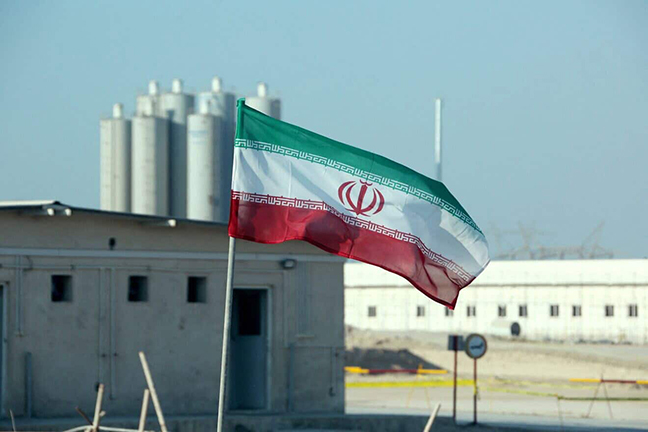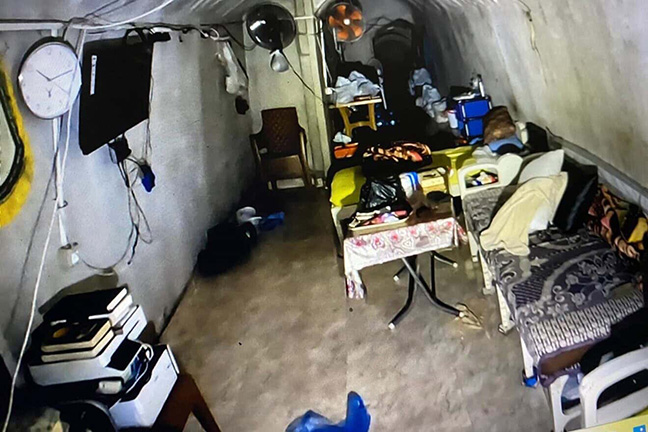The Iranian strike and Western pressure on Israel

A picture shows an Iranian flag in Iran’s Bushehr nuclear power plant, during an official ceremony to kick-start works on a second reactor at the facility on Nov. 10, 2019. Photo by Atta Kenare/AFP via Getty Images.
by Ari Sacher
On the night between April 13 and 14, Iran launched a salvo of close to 300 cruise missiles, killer drones and ballistic missiles at Israel. Nearly 99 percent of the drones and cruise missiles were destroyed by a coalition that included Israel, the U.S. and the U.K. Most were destroyed before entering Israeli airspace while nine of the ballistic missiles struck two Israeli air bases, causing minor damage. Israel’s response was muted: On April 19, three missiles were launched at an anti-aircraft battery next to an Iranian nuclear facility in Isfahan, destroying the radar. While Israel never officially took credit for the attack, there are no other suspects. Israel seemed to be telling Iran that it could hit Iran’s most sensitive sites at will and that this should serve as a warning shot.
The lesson was not heeded. On the night of October 1, Iran launched a salvo of about 200 ballistic missiles at Israel. While most of the missiles were intercepted by the Arrow-3 Anti-Ballistic-Missile System, a small number of them managed to impact Israeli Air Force Bases, again causing limited damage and not affecting the readiness of the Israel Air Force. After this second salvo, an Israeli retaliatory response was a sure thing. In the Middle East, deterrence is vital. In order to maintain its deterrence, Israel needed to strike back hard at Iran. The question was what would be targeted. Four primary options were on the table:
- Oil and gas production facilities
- Symbols of sovereignty, such as high-ranking officials, parliament buildings, and the clock in Palestine Square that shows the countdown to Israel’s destruction.
- Nuclear facilities
- Military facilities
While all options had their strengths and their weaknesses, Israel chose Option #4. On the night between October 25 to 26, more than 140 Israeli warplanes attacked targets in and around Tehran. While the Israel Defense Force is not divulging any information, sources on the internet are in agreement that two types of targets were struck:
Ballistic missile production facilities:
Most of Iran’s ballistic missiles have solid fuel rocket motors. The rocket fuel is made using a “batter,” similar to the way one would make a cake. Unsurprisingly, a key component in the production of rocket fuel is a mixer. Because the rocket propellant is extremely volatile, it is mixed using a special liquid-sealed mixer. Because the missiles are so large, these mixers can mix up to 600 gallons of rocket fuel. A mixer can cost about $2 million, and Iran owns between 12 and 20 of them. All of the mixers were destroyed in a strike on a facility in Parchin, about 30 miles from Tehran.
A very small number of companies around the world produce these kinds of mixers, and most of the companies are in western countries that are forbidden from selling ballistic missile components to Iran. This leaves China and Russia as the only two potential vendors for such mixers. The lead time to procure mixers is estimated between one and two years. The destruction of the mixers will be a significant setback for the Iranian ballistic missile program. While Iran still possesses a considerable arsenal of ballistic missiles, it will now have to manage their use because they are, for the moment, irreplaceable.
Air Defense System radars:
The most potent weapon in the Iranian air and missile defense arsenal is the Russian S-300. The system has similar performance to the well-known and venerable American PATRIOT system. The S-300 has a range of more than 100 miles. The S-300 is Iran’s only strategic air-defense system – all of its other systems have significantly less range and are designed to counter a much smaller threat set. Iran received four S-300 batteries from Russia in 2016, each consisting of a target-acquisition radar, a target-engagement radar, and four towed transporter-erector-launchers (TEL). The Israeli retaliatory strike destroyed all 4 target engagement radars, rendering the systems useless and leaving Tehran and Western Iran essentially unprotected to any follow-on Israeli attack.
The Israeli retaliatory raid can be deemed a success, for a number of reasons:
Israel attacked Iran in a “noisy” manner that caused serious damage to Iranian air defense systems and long-range ballistic missile production facilities. The raid itself cannot be denied or explained away by the Iranians. Deterrence consists of “Capability, Credibility, and Communication,” and Israel’s attack showed an abundance of all three components.
The Iranian attack on October 1 had limited success. No real damage was incurred, and only one Israeli casualty was sustained. What little success the attack had was due to the extent of the barrage and the penetration of several dozen missiles into the defense system. In the Israeli raid, most of the munitions accurately impacted their targets and caused significant damage. Air Defense capabilities were taken away and the production of ballistic missiles was damaged. No Iranian civilians were injured by errant missiles.
Compare this to the Iranian attacks that targeted the heart of the Tel Aviv metropolitan area with an unstated goal of causing as many civilian casualties as possible. The fact that all Israeli aircraft successfully penetrated the Iranian Air Defense and returned home safely is nothing short of remarkable. And this is the difference – Iran has great difficulty penetrating Israeli air defense, and anything that does manage to penetrate its defense is highly inaccurate. Israel, on the other hand, can hit any point in Iran accurately and painfully and negate critical capabilities. Iran has a rudimentary Air Force and Navy. Its capability to project power is limited to its ballistic missile force. As long as the exchange of blows continues, Israel will become more powerful, and Iran will become more weak.
On the other hand, the Israeli raid was not without its limitations:
Iran attacked with all its might. It launched two salvos using its most advanced missiles. These salvos were the largest in modern military history. Even though the damage was limited due to the prowess of the Israeli Integrated Air and Missile Defense, the attack had the potential to be far more deadly. Israel, on the other hand, operated using tweezers. It chose to damage a small number of military sites, which in a matter of months or years, despite the localized damage, will be repaired. No long term damage was incurred.
While Israel can still say, “We can do more than that!,” the attack left Iranian oil facilities and symbols of sovereignty standing. Destruction of these facilities would have had a far greater near-term and long-term effect.
It is clear that the Israeli attack catered to the interests of the current U.S. administration. Iranian nuclear facilities were not attacked due to the Israeli Air Force’s inability to single-handedly destroy the important targets deep underground – American GBU-57 MOP penetrator bombs are needed for that mission. And the Iranian oil industry, a vulnerable and relatively easy target that would have been particularly painful for the Iranian economy, was not attacked, more than likely due to Western pressure.
From a military standpoint, a stronger Israeli response is possible and even required, but Israel’s political considerations in view of the growing criticism of the war makes Israel largely dependent on American support. The Biden Administration is interested in de-escalation, and more forceful Israeli strikes would likely spur an immediate Iranian response. Ten days before a presidential election, this is a scenario the administration very badly wanted to avoid.
The U.S. is not the only country from which Israel needed tacit approval. Based on the debris found in Iraq – booster motors of long-range weapons and the like – it appears that the IAF flew over Syria and Iraq on their way to Iran, destroying detection radars along the way in order to keep their approach clandestine. Today, Syrian airspace is if not controlled by, then at least monitored by the Russians. According to reports on the internet, Israel and Russia have set up methods for deconfliction in order to ensure that Israel has the freedom to attack targets in Syria without accidentally hitting any Russian targets. Any route to Tehran that went through Syria, knocking out targets along the way, would have required Russian knowledge and sign-off. This would also serve to limit the target set, seeing as Iran and Russia have an agreement for a gas-oil swap in which Iran purchases Russian natural gas in return for crude oil. The Russians have a vested interest in keeping the Iranian crude flowing.
All things considered, Israel maximized the utility of its attack on Iran. It chose its targets in a way that would be useful but would not upset the world body politic. It removed Iran’s ability to defend itself in case of a future Israeli attack. It hit its targets with deadly accuracy, and all of its aircraft returned home safely. Not bad for one night’s work.
Ari Sacher is chief systems engineer of Iron Dome, and a senior policy advisor to U.S. Israel Education Association (USIEA), a nonprofit organization based in Birmingham that advances important dialogue and cooperation between bipartisan senior government leaders in the United States and Israel by filling existing information gaps and enhancing understanding of issues critical to a mutually beneficial partnership. Founded in 2011, USIEA empowers U.S. leaders with innovative initiatives on the path to Middle East peace, connects Members of Congress with direct access to West Bank visits, and educates as thought leaders in the media and through strategic global partnerships.



